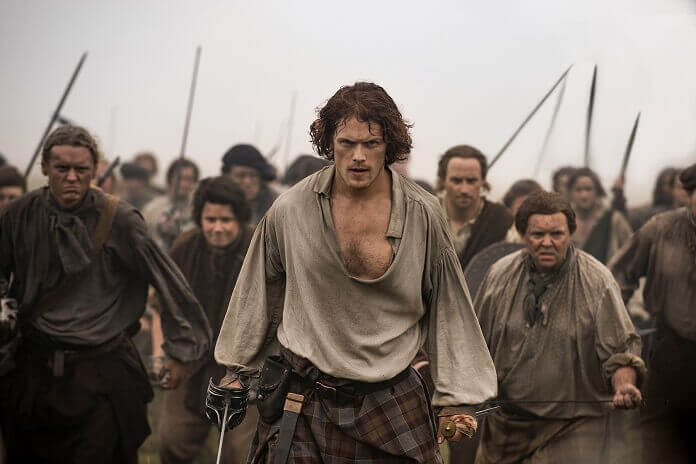
I can usually spot Ronald D. Moore at Outlander events wearing a kilt. For the Starz Television Critics Association party this summer, he was wearing khakis. I actually asked him about the switch to pants and he joked, “Well, you know, you’ve got to mix it up, keep everybody guessing.”
Season three of Outlander sees 20 years of Claire and Jamie’s lives apart, leading to Claire and Jamie’s daughter Brianna (Sophie Skelton) in the ‘60s with Roger (Richard Rankin). Here is our one-on-one interview with Moore at the TCA party including a look ahead to season four’s move to South Africa for production, and an ocean voyage for Claire (Caitriona Balfe) and Jamie (Sam Heughan). Outlander returns September 10, 2017 on Starz.
One of the fans asked about the decision to have Roger with a full beard. Why was it decided vs. clean shaven?
Ronald D. Moore: “I think we just decided that Richard looks really good in a beard. It was literally about that simple. I think he shaved it at one point and then we went, ‘Oh.’ If I’m remembering the order of events correctly, Maril (Davis) will correct me if I’m wrong, I think we saw him audition in a beard and then I think we saw him shaven and we all kind of went, ‘Aww, he looked so cool in the beard. Let’s have him grow it back.’ And it looked really good.”
How does Brianna as an adult change the dynamic between Claire and Frank?
Ronald D. Moore: “We don’t play that too much because the way the season is structured, she’s just graduating high school and then Claire and Frank (Tobias Menzies) have their ultimate break and then he passes away. So, you don’t really get a chance to explore that aspect of the relationship too much this season. We have talked about in later years, season four and five, as we get more into Brianna, we might be talking more about her backstory and her relationship with her father and then maybe more about what it was like when there were the three of them and she was on the cusp of adulthood.”
But growing up she changed their dynamic.
Ronald D. Moore: “Oh, yes. As a child, yeah, because it’s what kept them together. They had both committed to raising her as two parents and that was the defining characteristic of their relationship for a long time. Once they had realized it wasn’t going to work out between the two of them, they had reached some accommodation of, ‘We’re going to live separate lives in the same house but we both love this girl and we’re both going to be her parent.’ That was the glue that held the whole thing together for a very long time.”
So, she affected them positively.
Ronald D. Moore: “Oh yeah, absolutely.”
Tobias said he thought about Frank’s separate life, even though we don’t really see it. Did you and he discuss that?
Ronald D. Moore: “Not really. We might have had a passing conversation about it. We did talk about it back in season one when we did the episode where we cut to Frank’s point of view when Claire was gone. We were talking about Frank’s life after she was missing and then after he finally gave up about her and went on to Oxford and tried to carry on. When she returned at the beginning of season two, we did have some conversations about where Frank was emotionally. He’d given up the idea of ever seeing her again. He’d kind of reconciled himself to that and he was trying to move on. He hadn’t quite let go of her but he was moving down that path. We had those kinds of conversations.”
Do the time jumps over the 20 years happen at relatively the same intervals?
Ronald D. Moore: “No. We did try to structure that initially but it didn’t really match up so it’s not literally five years pass in Jamie’s story and five years in Claire’s. It’s more thematic. Thematically things are parallel in between the stories but not literally in terms of chronology.”
When you move to South Africa, not all the stories are on the ship but do you have to build all your sets there?
Ronald D. Moore: “We built most of them there. Beaches and tropical jungles and huts and all that wasn’t something we could accomplish in Scotland. We did do some interiors in Scotland. There’s a big scene at the governor’s mansion that we did shoot in Scotland before we even went to South Africa, but most of the story, once Jamie and Claire get on the ship to the end of the season, the vast majority of that was shot in South Africa either on location or on their soundstages.”
When new cast members like Sophie and Richard come in, do you have any way to prepare them for Outlander fans?
Ronald D. Moore: “Not really. You sort of have a general conversation with them but it’s the kind of thing you have to experience to even understand. You say okay, this is a big fandom, there’s going to be a lot of publicity requests. There’s a lot of interaction with fans. You’re probably going to be invited to conventions and so on. Then other cast members probably talk to them more because now they’ve gone through it. Generally, you just let them experience it on their own.”
The ‘60s itself is a period piece. How does recreating that compare to older times in Scotland or WWI?
Ronald D. Moore: “It’s very similar. All the 20th century scenes, whether they’re ‘40s, ‘50s or ’60 have similar challenges in that you are creating a period that doesn’t exist but there’s a lot of rentals and a lot of actual items that are still available and sitting around. You can go rent a refrigerator from the 1940s and ‘50s. You can rent some background clothes for that period. The cars still exist. When you’re doing the 18th century, virtually none of that still exists. What does exist is probably a museum piece so you’re recreating it in some fashion.”
Is it close enough where you can be in modern locations and you have to CG out the modern parts?
Ronald D. Moore: “Yeah, in the trailer that you saw today, there’s just a quick shot of the Boston street where Claire’s car pulls up in the street. That was shot on location in Glasgow on a street that looked very much like Boston, had a brownstone look to it. Down the road, we took out Glasgow and in CGI we created some steeples and what looks sort of like Boston in the far distance. Then the post-production crew goes through every frame basically looking for things that are anachronistic. Signage. Is there a satellite dish? Little things that the average viewer probably isn’t even going to see but you have people that do nothing but look frame by frame for anything in the shot that might be anachronistic to the period.”
Are you able to see any of the politically charged time of the ‘60s through Roger and Brianna?
Ronald D. Moore: “A little bit. We refer to it, we talk about it a little bit. It’s not a dominant aspect of those stories but it colors their experience.”
We’ve seen Claire without Jamie before. Is seeing Jamie without Claire a very different look at him?
Ronald D. Moore: “It is. It’s also a very interesting journey because his stories are so different. The chapters of the book for Jamie in season three, this episode he’s at the battle of Culloden and this episode he’s living in a cave and this episode he’s in prison and this episode he’s at Hellwater and this episode he’s at a print shop in Edinburgh. So, you have these five chapters of a man’s life over 20 years and he knows different people, he’s got different relationships, he’s at a different place in his life in each one of those. So, it’s really an opportunity to open him up in a very different way.”
Is the romance almost gone for Claire?
Ronald D. Moore: “Well, she’s holding onto a romantic idea. For all intents and purposes, she’s given up ever seeing Jamie again, but she can’t let go of what he meant to her in her heart. So, she’s holding onto this romantic notion emotionally even though she’s intellectually trying to move past it.”
– Caitriona Balfe Interview
– Tobias Menzies, Caitriona Balfe and Sam Heughan Press Conference
– One-on-One with Richard Rankin on Playing Roger
– Exclusive Interview with Sophie Skelton






